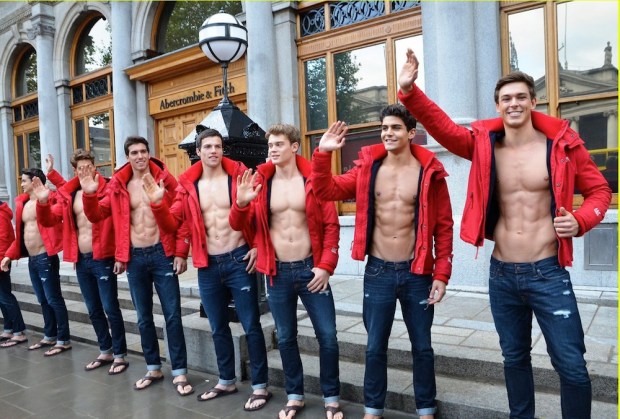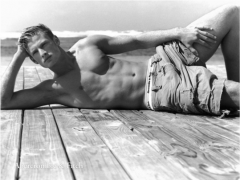How Abercrombie & Fitch Is Bringing Unsexy Back (And Why It’s Working)

The greatest mind of the millennial generation, Justin Timberlake, has achieved much in his short life that rightfully makes him an inspiration to others. And while his achievements in the field of drama, music and comedy all have a patina of excellence upon them, his greatest achievement and the basis for his eventual Nobel Peace Prize is basically inarguable.
In 2006, he brought sexy back. Where did it go? We don’t know. How exactly did he bring it back? It’s hard to explain, but it undeniably occurred.
And, from then on, it seemed Justin Timberlake owned sexy — at least for marketing purposes.
Consider the tragedy of Abercrombie & Fitch. The once very sexy and trendy clothier suddenly and dramatically shed 88 percent of its share price in the two-year period after the release of “SexyBack.” And that was after 12 years of, more or less, consistent growth that saw its stock price increased sevenfold. Now, granted, economy-watchers perhaps somewhat less prone to using Justin Timberlake to explain macroeconomic trends might be tempted to point out that the period where “SexyBack” dominated the airwaves was also the time period where the debt securitization bubble ran into its last and most insanely overheated days before bursting and taking the entire global economy down with it.
Those less creative sorts might be inclined to point to the fact that it was probably the great economic reckoning that was the Great Recession that is more to blame for gutting Abercrombie’s market cap, as it was responsible for many such guttings.
And while we are willing to concede that there are problems with our Timberlake theory, Abercrombie’s problems run much deeper than a Great Recession-inflicted haircut and a resulting battle back with the rest of the consumer economy. Because the truth is: Abercrombie has not battled back all that well, especially in the last four or five years when speculation on its imminent demise have become de rigueur.
Some of those wounds are typical of the retail death spiral narrative of the last few years — a mall store in a mall increasingly less popular and unmoored by dominant anchor chains. But some of those wounds were curiously self-inflicted and perhaps a sign of out-of-touchedness with the shoppers of today.
What’s interesting now, however, is that the bleeding seems to have stopped and the patient is improving.
Dramatically, as it turns out. Same-store sales in the fourth quarter shocked the world and actually went up — a tiny amount but up nonetheless. The bigger headline, however, is the store’s profits, which jumped 30 percent. Also on the uptick? Direct-to-consumer and omnichannel sales, which grew to roughly 28 percent of total company net sales for the fourth quarter, compared to 27 percent of total company net sales last year.
“We were pleased to deliver results in line with our expectations against the backdrop of a challenging environment that included currency, traffic and weather headwinds,” said Arthur Martinez, executive chairman. “Our results for the fourth quarter reflect continued progress on a number of fronts and included a return to positive comparable sales, higher average unit retails as promotional activity was moderated and meaningful improvement in adjusted operating income on a constant currency basis. In addition, inventory continued to be well-managed, and we generated strong free cash flow for the year.”
Something went right for Abercrombie. Can it keep capitalizing going forward? The answer to that is found in…
A Brief History Of What Went Wrong With Abercrombie & Fitch
Since its early days, Abercrombie has been known industry-wide for two things.
The first was its heavy inclination toward branding all of the clothing it sells. For a brief period in the late 90s and early 2000s, it was actually impossible, in some parts of the country, to walk for more than 25 feet without running into a human being with the words “Abercrombi e & Fitch” emblazoned on them someplace.
e & Fitch” emblazoned on them someplace.
The second was its distinctive — and, by some accounts, “softcore pornographic” — advertising materials, which made liberal use of extremely attractive, semi-clothed and likely underaged models lounging about sexily.
You’ll note that, even though the model in the picture on the left is wearing almost nothing, you can still clearly read the words Abercrombie & Fitch on his underwear.
The problem Abercrombie ran into is the problem that any shock-based marketing campaign runs into. One, consumers get used to it and tune it out; two, others learn to do it better. American Apparel upped the ante on softcore ads, and eventually, even they managed to elicit more yawns and yawps from consumers.
The trend lines eventually pulled away from Abercrombie’s highly branded, young-and-the-beautiful marketing. Abercrombie also found that, suddenly, in a more social media-fueled world, people did not love CEO Mark Jefferies’ attitude about customers and inclusivity.
“We go after the attractive all-American kid with a great attitude and a lot of friends,” Jeffries told Salon. “A lot of people don’t belong [in our clothes], and they can’t belong.”
Jeffries, in the same interview, also affirmed that the stores intentionally only staff good-looking people.
“Good-looking people attract other good-looking people, and we want to market to cool, good-looking people,” he told Salon. “We don’t market to anyone other than that.”
Jeffries gave that interview in 2006. It was regularly quoted in any story about Abercrombie’s woes for the next nine years until Jeffries stepped down in 2014.
The New “Unsexy Era”
As the 2010s reached their halfway mark, Abercrombie found itself in the unenviable position of being a mall-based retailer with a bad attitude about inclusion and clothes out of step with consumer preferences.
Change was inevitable, since the only other option on the table seemed nonexistence.
So, Abercrombie got away from marketing to the “cool kids” and stopped the sexy advertising. That meant no more shirtless models on the promotional materials or at store openings, and sales clerks (now called “brand representatives” instead of “models”) are no longer officially hired for conforming to a certain look. That particular change came in response to losing a lawsuit to a Muslim employee after a court found the chain could not force her to remove her headscarf while at work.
The chain also isn’t quite interested in that super young, very popular consumer anymore; it’s content to market instead to their older sibling, cool aunt or hip English teacher.
The brand has moved its focus to older millennials and younger Gen Xers — the same people who helped grow the brand to supersized proportions during the shirtless model days. Those people — now in their 30s — are being enticed instead with better lighting, quieter background music and a more diverse accessory collection. The company’s younger millennial focus has moved to the fast-fashion Hollister brand, which continues to average better sales and better growth than the flagship Abercrombie & Fitch brand.
And though Hollister continued to be the main growth driver in Q4, A&F classic started, for the first time since 2012, to significantly close the gap between them.
“2015 was a year of tremendous change for us,” Martinez added. “We completed our move to a branded structure, strengthened our teams and improved our core processes. More importantly, we evolved our assortment, and we refocused our attention on our customer through greater accountability and empowerment at the store level and through changes in our in-store experience.”
Net sales at the A&F chain still fell 3 percent to $509.4 million, versus a 9 percent drop in 2015. And the losses weren’t equal. Women’s clothing and international sales grew, though the menswear losses cancelled out the growth.
The chain is also much smaller than it once was and plans to get smaller still, with 50 additional closings planned for this year. A&F is also redesigning itself via a new store prototype, which it expects to roll out later this year, though there is no word yet on what that actually means.
Will it be enough? That remains to be seen.
But Abercrombie & Fitch, if nothing else, is an interesting lesson for retailers to learn from, especially when it comes to universal truths — in this case, the old marketing adage “sex sells.”
As it turns out, not always — only if your audience is mostly interested in that sort of thing. Once they age past college, sex does not sell; good lighting and quieter music, on the other hand, are a big hit.
